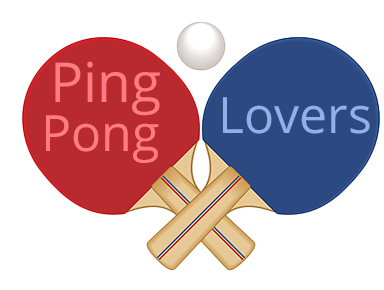Are you ready to bring the excitement of ping pong into your home or office? Choosing the perfect ping pong table dimensions is essential for creating an enjoyable and comfortable playing experience.
In this blog post, we’ll guide you through understanding standard table dimensions, factors to consider when selecting a table, and customizing options to create a unique playing experience tailored to your needs.
Key Takeaways
- Discover your space’s perfect ping-pong table dimensions, regulated by ITTF!
- Get ready to choose from a variety of materials, thicknesses & colors to suit your desired playing level.
- Customize with custom sizes and design options for an ultimate unique experience!
Understanding Standard Ping Pong Table Dimensions
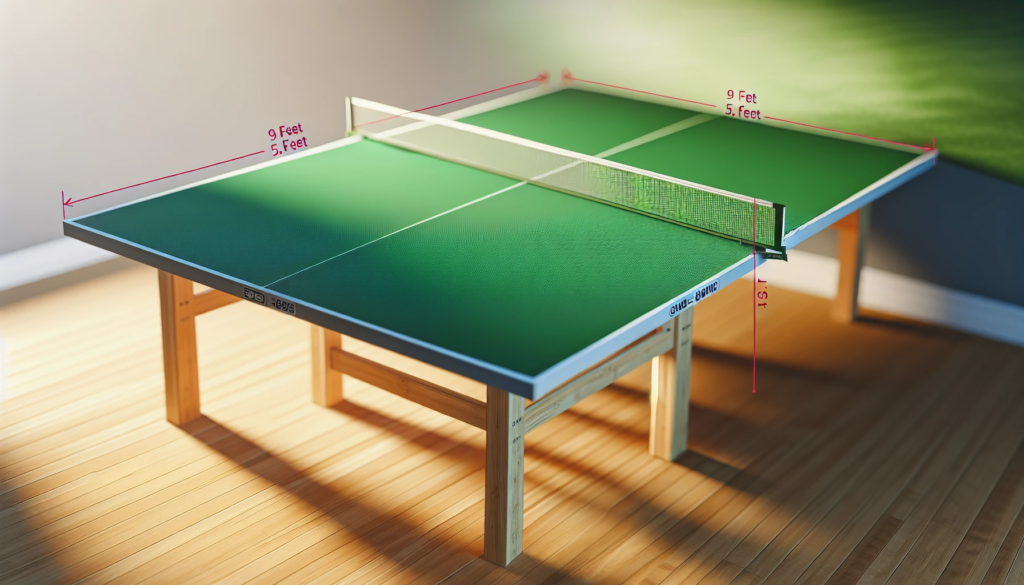
Understanding the standard dimensions of a ping pong table significantly aids in choosing the appropriate table for your space. Regulated by the International Table Tennis Federation (ITTF), standard dimensions ensure a consistent playing experience across various table tennis tables, whether you’re a casual player or a professional athlete.
Length, Width, and Height
As regulated by the ITTF, a standard ping pong table measures 9ft long, 5ft wide, and 2.5ft tall. To ensure you have enough room to play comfortably, it is recommended to have a room size of at least 19’ long by 11’ wide.
Additionally, you’ll want to have approximately 3’ of space on each side and 5’ at each end of the table for optimal play. And let’s not forget about the net height, which should be 15.25cm or 6 inches.
Remember that these dimensions are for standard-sized tables, and more compact options are available for those with limited space. Add one foot to the formula for smaller tables, and you’ll have a minimum space of 2’ per side and 4’ per end, perfect for maintaining a good ball bounce.
Playing Surface Area
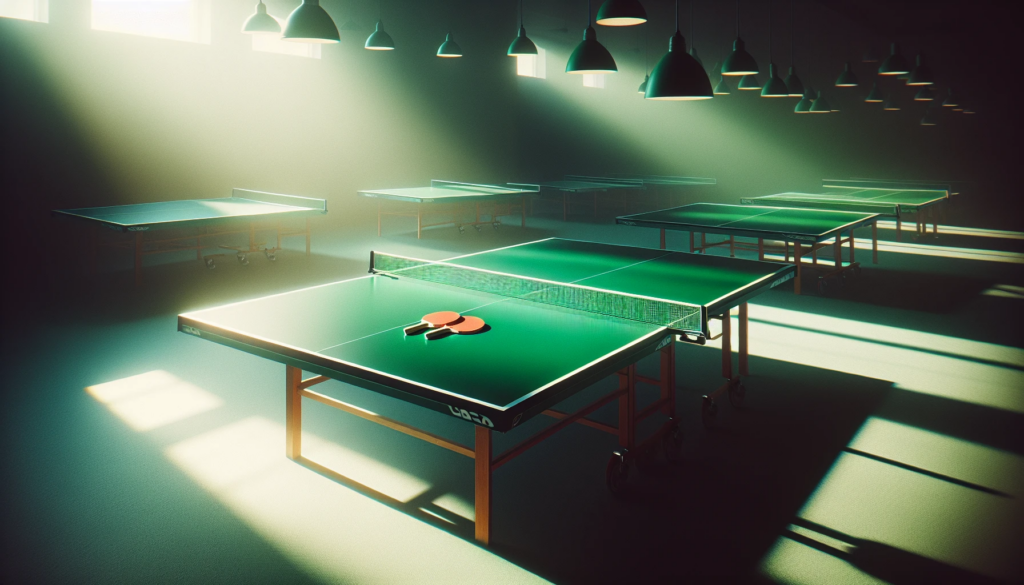
The playing surface area of a standard ping pong table is 45 square feet. This surface area plays a vital role in determining table dimensions and directly impacts gameplay. A proper playing surface area ensures a fair and consistent gameplay experience, affecting:
- spin potential
- bounce height
- ball slippage
- room for play
Thus, regardless of whether you are a beginner or a seasoned player, a table with an accurate playing surface area significantly enhances the enjoyment of the game.
Factors to Consider When Choosing a Ping Pong Table
Selecting a ping pong table requires considering aspects like its purpose, available space, and preferred features. These factors will help you determine the best table for your needs, whether you’re a recreational player looking for some family fun or a serious competitor gearing up for tournament play.
Purpose: Competitive vs. Recreational Play
The purpose of your ping pong table will significantly impact the required specifications. Competitive tables are typically made with a thicker surface, usually 25mm or more, providing a consistent and fast bounce for high-level play. These tables often meet specific size and height regulations set by official governing bodies like the ITTF.
On the other hand, recreational tables may have a thinner surface and not offer the same level of playability as competitive tables, but they still provide a fun playing experience for casual players and families. Determining whether the table will be used for competitive or recreational play is a significant factor, as this affects the table’s quality, thickness, and dimensions.
For instance, professional players tend to prefer tables that are 25mm or thicker for optimal bounce and playability, while recreational players may be content with a thinner surface.
Available Space: Room Size and Ceiling Height
Considering the room size and ceiling height while selecting a ping pong table is necessary to ascertain enough space for a comfortable playing environment. The minimum room size recommended for a standard ping pong table is around 17-18 feet in length and 9-10 feet in width, with at least 5 feet of space behind each end of the table and 3 feet to each side for optimal gameplay. Additionally, the ceiling height should be at least 9 feet (2.75 meters) for optimal play.
A larger room allows for more freedom of movement and reduces the chances of hitting obstacles, providing more playing space for players to generate power in their shots. On the other hand, a smaller room may limit the player’s range of motion and make it more difficult to execute certain shots. So, it’s essential to consider the available space when choosing a ping pong table to ensure the best playing experience possible.
Desired Features: Material, Thickness, and Color
Selecting a ping pong table involves considering the preferred material, thickness, and color according to your needs. Typical materials used for ping pong tables include:
- Plywood
- Particle-board
- Metals
- Plastics
- Concrete
- Fiber
The thickness of a ping pong table affects the ball’s bounce, with thicker tables generally providing a better bounce compared to thinner tables. The tabletop thickness can range from 12mm to 30mm, with thicker tables offering a higher-quality playing surface.
The color of the table also plays a role in the playing experience. Dark colors like green or blue with a matte finish are preferred for tournament tables, as they provide better contrast with the white ball, making it easier to see during the game. Ultimately, the choice of material, thickness, and color will depend on your personal preferences and the level of play you desire.
Space-Saving Ping Pong Table Options
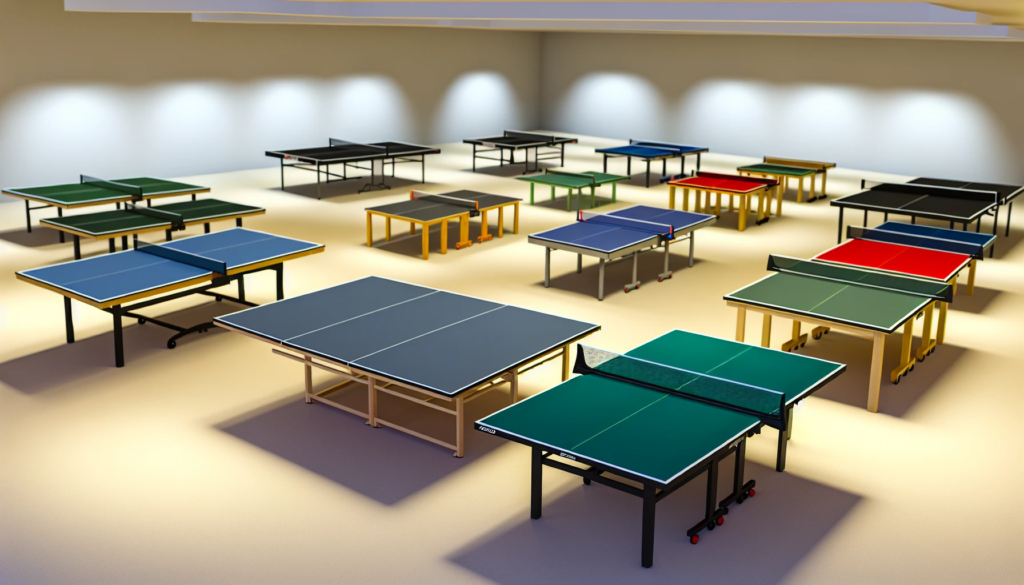
A variety of space-saving ping pong table alternatives are available for those with limited space or seeking more adaptable choices. These include compact tables, conversion tops, and foldable/portable tables that can be easily stored and transported, making them ideal for multi-purpose spaces or smaller rooms with space-saving storage needs.
Compact Tables
Compact tables are smaller in size and suitable for limited spaces or beginner players. While they may not be suitable for professional play, compact tables still provide a fun playing experience for recreational use or smaller spaces where a full-sized table may not fit. These tables often come with features like a thick playing surface and a robust undercarriage, ensuring a solid playing experience.
Bear in mind compact tables, due to their smaller dimensions, may not offer the same level of play as standard-sized tables. Nonetheless, they still offer an enjoyable playing experience for recreational players and those with limited space.
Conversion Tops
Conversion tops are a cost-effective and space-saving option that can be placed on existing tables, such as pool tables, to create a ping-pong playing surface. This versatile solution allows you to enjoy the game without the need for a dedicated ping-pong table, making it perfect for those with limited space or budget.
While conversion tops may not offer the same level of playability as dedicated ping pong tables, they still provide casual players with a fun and enjoyable playing experience. Ensuring that the conversion top is securely attached to the underlying table and that there is ample space around the table for relaxed play is significant.
Foldable and Portable Tables
Foldable and portable tables can be easily stored and transported, making them ideal for multi-purpose spaces or for those who want to take the fun of ping pong wherever they go. These tables are designed with sturdy construction and made of durable materials, ensuring a solid playing surface. Some features of foldable tables include:
- Easy storage and transportation
- Sturdy construction
- Durable materials
- Solid playing surface
- Ability to fold up on one side for solo play
Handling the table with care and following appropriate steps to fold and unfold a ping pong table properly helps avoid damage., such as removing the net and posts, folding the legs, and lifting the table gently when unfolding. By taking these precautions, you can ensure your foldable and portable table remains in top condition for years to come.
Outdoor Ping Pong Tables: Enjoying the Game Outside
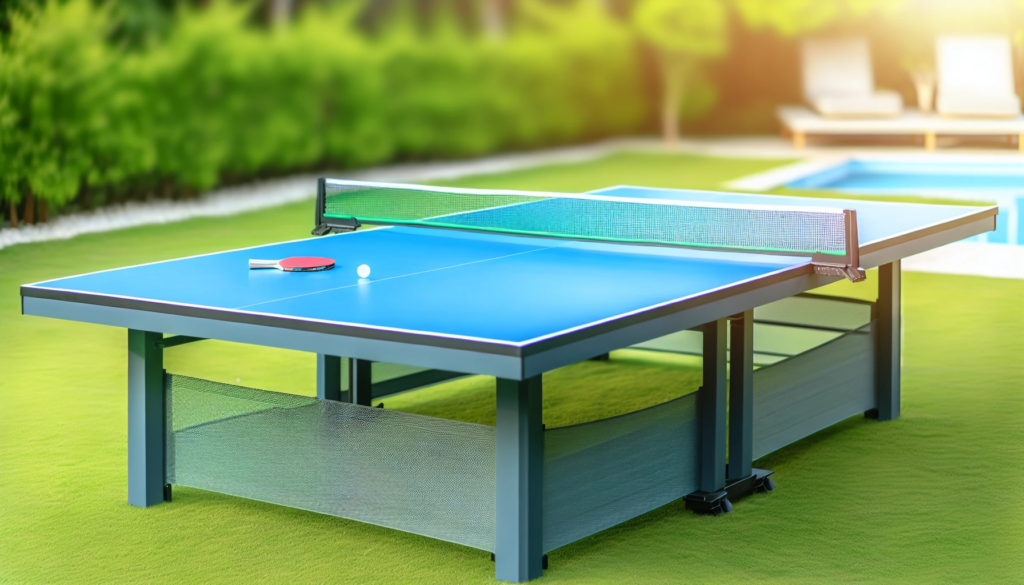
Outdoor ping pong tables, a popular choice among outdoor table enthusiasts, allow you to play table tennis outside, bringing the excitement of the game to your backyard, parks, or other outdoor spaces. However, these tables require weather-resistant materials and proper maintenance to withstand various weather conditions and prolong their lifespan.
Weather-Resistant Materials
A significant aspect is selecting an outdoor ping pong table made from weather-resistant materials, such as aluminum, stainless steel, or treated wood. These materials are designed to be durable and weather-resistant, ensuring the table remains in good condition even when exposed to rain, snow, or sun.
Aluminum composite, for example, performs amazingly well as a material for outdoor ping pong tables due to its weather-resistant properties. Choosing a table made of the right materials ensures that your outdoor ping pong table remains in top condition and provides an enjoyable playing experience for years to come.
Proper Maintenance and Storage
Correct maintenance and storage are necessary to extend the lifespan of your outdoor ping pong table. To store an outdoor table properly, follow these steps:
- Find a sheltered location away from direct sunlight and rain.
- Cover the table with a tarp or ping pong table cover to protect it from dust and debris.
- Remove the net when not in use to prevent damage.
Regular cleaning and maintenance should be done to ensure the table is in good condition. To clean an outdoor table effectively, you can use a mixture of vinegar and warm water or a diluted rubbing alcohol and dishwashing soap solution. Wet a sponge or microfiber cloth with the cleaning solution and gently scrub the table surface, making sure to remove any sticky residue or dirt.
Afterward, wipe the table dry with a clean cloth to keep your outdoor ping pong table looking and playing its best.
Customizing Your Ping Pong Table
Customizing your ping pong table enables the creation of a unique playing experience that caters to your needs. Whether you need a table with specific dimensions to fit your room or want a table with a personalized design, customizing options can help you create the perfect table for your space and playing style.
Custom Table Sizes
Custom table sizes can be designed to fit specific room dimensions or player preferences, ensuring the perfect fit for your space and needs. Customizing the size of a ping pong table can affect gameplay in several ways, such as impacting the playing style of taller players or the thickness of the tabletop, which in turn affects the speed of the game.
Accurate measurement of your available space is necessary when considering a custom-sized ping pong table, considering the width of the table and the additional space required on each side. Doing so ensures that your custom table will provide an enjoyable playing experience while fitting seamlessly into your space.
Design and Finish Options
Design and finish options allow you to personalize your table’s appearance and functionality, creating a unique look that reflects your style and preferences. Options for customizing your table include using different materials for the playing surface, adding custom logos or lettering to the net, and choosing custom colors for the table.
The finish of a ping pong table is another important consideration, as it can greatly affect playability. Older tables with worn finishes may be slower and have a less consistent bounce, while the type of finish used on the table can significantly impact the speed and grip of the ball.
By choosing the right design and finish options, you can create a ping pong table, also known as a tennis table, that looks great and provides an exceptional playing experience.
Summary
In conclusion, choosing the perfect ping pong table dimensions and customizations is essential for creating an enjoyable and comfortable playing experience. By understanding standard table dimensions, considering factors such as purpose, available space, and desired features, and exploring customization options. So, whether you’re a casual player looking for some family fun or a serious competitor gearing up for tournament play, invest in the right ping pong table and enjoy the thrill of the game!
Frequently Asked Questions
Is a pong table 6 or 8 feet?
A beer pong table is officially 8 feet long, 2 feet wide, and 27.5 inches off the ground, with a distance between the front two cups in a 10-cup game of roughly 65”. So, a pong table is 8 feet long.
What is the minimum space required for a standard ping pong table?
For the best ping pong experience, you’ll need a room that’s 19′ long and 11′ wide – plenty of space to keep your rallies going!
What is the difference between a competitive and recreational ping pong table?
Competitive ping pong tables are designed to meet specific size and height regulations, with a thicker playing surface for top-level performance, while recreational ping pong tables offer a more relaxed experience with a thinner playing surface and greater flexibility in size.
How can I properly maintain and store an outdoor ping pong table?
Proper maintenance and storage of an outdoor ping pong table is key to long-term enjoyment. Find a sheltered area, cover the table with a tarp or table cover, remove the net when not in use, and clean the surface with mild detergent and water to keep it looking great!
